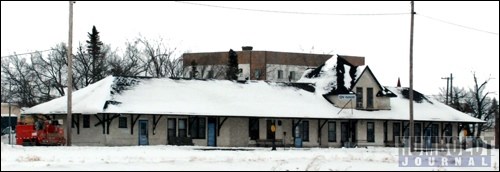CN Rail has made some major changes to its buildings in Humboldt over the past few months, which has left the historic train station empty and unused, at least for now.
First, the old Humboldt bunkhouse was torn down, and another building put up in its place. Late last year, CN crews stopped using the old train station building, which had housed their offices for decades, and the City of Humboldt was invited in to assess the building, which is a national heritage site.
When questioned about these changes by the Journal, CN Rail would share generalities, but not details about why the changes were made.
Warren Chandler, a CN Public Affairs officer for the Prairies, who is based in Edmonton, had this to say about the buildings:
"The old Humboldt Bunkhouse had not been in use for over two years. The building needed significant repairs and so the decision was made to have the unused building taken down and replaced with a new office structure....
"The old bunkhouse was no longer required and had not been used in over two years. The new office building was built to better serve the different functions that CN requires....
"In the same location CN recently finished a new multi-functional office building which is used by on site CN employees and train crews who operate out of Humboldt.
"The (old) train station building is no longer in use, however it has been deemed a heritage site by the Federal Government.
"CN has no current plans for the (old) train station building that is no longer in use."
However, the company is open, he added, to meeting with any local or provincial groups regarding the preservation of the station, should they make a request.
The City of Humboldt was more forthcoming about their possible involvement in the heritage train station in the future.
The City was offered the building before Christmas, noted Darrell Lessmeister, Director of Leisure Services with the City of Humboldt. A group of city employees and members of city council toured the building at that time and noted some concerns about its age and condition, both inside and out.
"We're assessing it right now... to see the feasibilities and possibilities," Lessmeister said of the building.
Complicating the possibilities for the train station are both its location and its condition.
As far as Lessmeister knows, the building has to stay in its current location, right next to an active rail line, according to the rules regarding national heritage sites.
"It can't move," he said. "That's not an option at this point... So that limits what we can and cannot do."
Whatever happens with the building, a fence or some other barrier will have to be installed between the building and the rail line, for safety reasons, he added.
Add to that the "questionable" condition of the building, which was how Lessmeister described it, and it's really unclear at this point how the city could use it, or what it would cost to get the building into better condition.
At the same time, it's worth some effort studying, he indicated.
"It's an important heritage site.... We've got to explore it and see what the options are, and assess the feasibility to it."
Lessmeister is preparing a report which will be presented to city council when it is finished.
He has been looking at other places, he noted, and how they have used their historical train stations once the rail companies discontinued using them. Some have been turned into museums, and others in restaurants. But it's usually municipalities that take on ownership from the rail companies, he revealed.
What the former stations are used for, he said, "has to do a lot with where they are located and the condition they are in."




